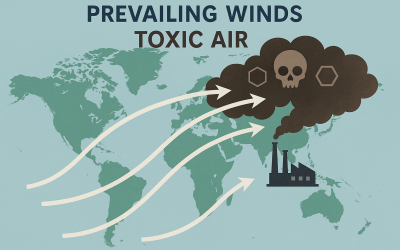Air Pollution Reduction Trees by USDA Hardiness Zone
General Planting Guidelines
- Optimal density: 50-100 trees per acre for maximum air pollution reduction
- Minimum effective density: 25-30 trees per acre for noticeable improvement
- Mixed species approach: Plant 3-5 different species for biodiversity and resilience
- Strategic placement: Plant within 300 feet of pollution sources for maximum effectiveness
USDA Zones 3-4 (Northern Regions)
Best Air-Filtering Trees
- Sugar Maple (Acer saccharum) – Excellent for PM2.5 and ozone
- American Linden (Tilia americana) – High pollution tolerance
- White Pine (Pinus strobus) – Year-round filtration
- Norway Spruce (Picea abies) – Dense canopy for particle capture
- Paper Birch (Betula papyrifera) – Fast-growing, good for NO2
Planting Density
- Large trees (Sugar Maple, Linden): 25-30 per acre
- Medium trees (Birch): 40-50 per acre
- Evergreens (Pine, Spruce): 30-40 per acre
USDA Zones 5-6 (Transitional Regions)
Best Air-Filtering Trees
- London Planetree (Platanus × acerifolia) – Exceptional urban pollution tolerance
- Red Oak (Quercus rubra) – Large canopy, excellent PM removal
- Eastern Red Cedar (Juniperus virginiana) – Evergreen year-round filtering
- Honey Locust (Gleditsia triacanthos) – Drought tolerant, good for urban areas
- American Elm (Ulmus americana) – Disease-resistant varieties available
Planting Density
- Large trees (Oak, Planetree): 20-25 per acre
- Medium trees (Elm, Honey Locust): 35-45 per acre
- Evergreens (Red Cedar): 40-50 per acre
USDA Zones 7-8 (Moderate Climate)
Best Air-Filtering Trees
- Southern Magnolia (Magnolia grandiflora) – Large leaves, excellent particle capture
- Bald Cypress (Taxodium distichum) – Pollution tolerant, adaptable
- Sweetgum (Liquidambar styraciflua) – Fast-growing, good air cleaner
- Live Oak (Quercus virginiana) – Massive canopy, evergreen in warmer areas
- Loblolly Pine (Pinus taeda) – Fast-growing evergreen
Planting Density
- Large trees (Magnolia, Live Oak): 15-20 per acre
- Medium-large trees (Sweetgum, Bald Cypress): 25-35 per acre
- Pines: 30-40 per acre
USDA Zones 9-10 (Warm Climate)
Best Air-Filtering Trees
- Chinese Elm (Ulmus parvifolia) – Excellent urban pollution tolerance
- Southern Live Oak (Quercus virginiana) – Massive air-cleaning capacity
- Bald Cypress (Taxodium distichum) – Thrives in various conditions
- Camphor Tree (Cinnamomum camphora) – Dense canopy, pollution resistant
- Mexican Buckeye (Ungnadia speciosa) – Native, drought tolerant
Planting Density
- Large trees (Live Oak, Camphor): 12-18 per acre
- Medium trees (Chinese Elm, Buckeye): 30-40 per acre
- Multi-story planting: Include understory trees at 50-60 per acre
USDA Zones 11-13 (Tropical/Subtropical)
Best Air-Filtering Trees
- Ficus (Ficus benjamina and varieties) – Excellent leaf surface area
- Royal Poinciana (Delonix regia) – Large canopy, beautiful flowers
- Mahogany (Swietenia mahagoni) – Dense foliage, pollution tolerant
- Australian Pine (Casuarina equisetifolia) – Fast-growing, salt tolerant
- Coconut Palm (Cocos nucifera) – Coastal areas, unique filtration
Planting Density
- Large trees (Mahogany, Royal Poinciana): 10-15 per acre
- Medium trees (Ficus varieties): 25-35 per acre
- Palms: 20-30 per acre
Where to Buy Trees
National Suppliers
- Arbor Day Foundation (arborday.org) – Wide selection, zone-appropriate trees
- Nature Hills Nursery (naturehills.com) – Large inventory, ships nationwide
- Fast Growing Trees (fastgrowingtrees.com) – Specializes in larger specimens
Regional Nurseries (Recommended)
- Northeast: Van Engelen Bulbs (Connecticut), Spring Hill Nursery
- Southeast: Almost Eden Plants (Louisiana), Ty Ty Nursery (Georgia)
- Midwest: Johnson’s Nursery (Wisconsin), Jung Garden Company
- Southwest: Trees of Texas Nursery, Moon Valley Nurseries
- West Coast: Las Pilitas Nursery (California), Dennis’ 7 Dees (Oregon)
Local Sources
- Contact your County Extension Office for local nursery recommendations
- State forestry departments often sell native seedlings at low cost
- Municipal tree programs may offer discounted trees for residents
Organic Care Guidelines
Soil Preparation
- Test soil pH – Most trees prefer 6.0-7.0 pH
- Add organic compost – 2-4 inches mixed into planting area
- Mycorrhizal inoculant – Enhances root development and nutrient uptake
- Avoid chemical fertilizers – Use organic alternatives
Organic Fertilization
- Compost tea – Apply monthly during growing season
- Fish emulsion – Diluted application every 6 weeks
- Bone meal – Slow-release phosphorus for root development
- Kelp meal – Provides trace minerals and growth hormones
Natural Pest Management
- Neem oil – Organic fungicide and insect deterrent
- Beneficial insects – Encourage ladybugs, lacewings, and birds
- Companion planting – Marigolds, basil, and other pest-repelling plants
- Integrated Pest Management – Monitor and treat only when necessary
Watering and Mulching
- Deep, infrequent watering – Encourages deep root growth
- Organic mulch – 3-4 inches of wood chips, leaves, or bark
- Drip irrigation – Water-efficient delivery system
- Rain water collection – Sustainable water source
Maintenance Schedule
- Year 1-2: Weekly watering, monthly organic feeding
- Year 3-5: Bi-weekly watering, seasonal fertilization
- Ongoing: Annual pruning, mulch renewal, soil testing every 3 years
Maximizing Air Pollution Reduction
Strategic Placement
- Windward side of pollution sources (roads, factories)
- Create tree corridors between pollution sources and living areas
- Multi-layered canopy – Combine tall trees with understory species
- Dense plantings near windows and outdoor living spaces
Maintenance for Optimal Performance
- Regular pruning maintains healthy leaf coverage
- Adequate spacing prevents competition and disease
- Diverse species reduces risk of widespread pest or disease issues
- Monitor tree health – Stressed trees are less effective at pollution removal
Expected Air Quality Improvements
Based on recent studies, properly planted trees can achieve:
- 37% reduction in particulate matter near roadways
- 7% reduction in ultrafine particles
- 0.5-1% overall improvement in neighborhood air quality
- Significant reduction in ozone, nitrogen dioxide, and sulfur dioxide levels
Note: Results vary based on local conditions, tree health, and pollution sources. Consult with local arborists and extension agents for site-specific recommendations.




0 Comments